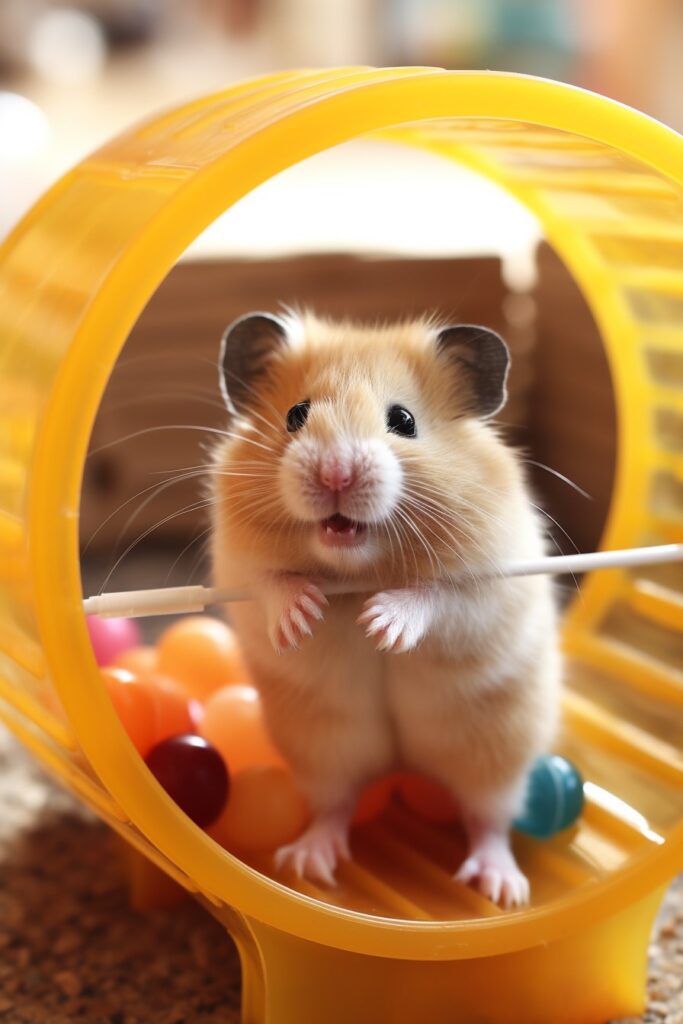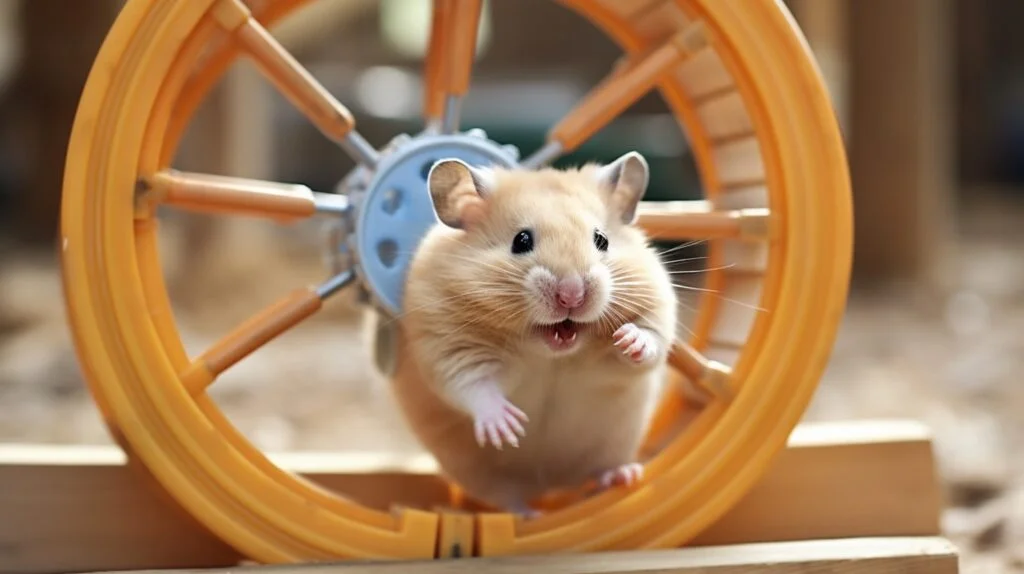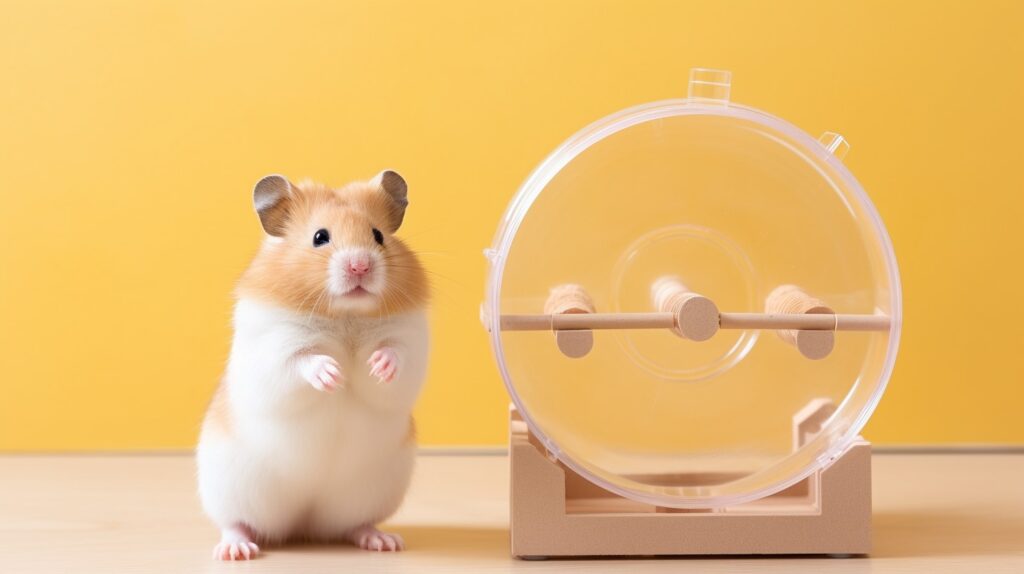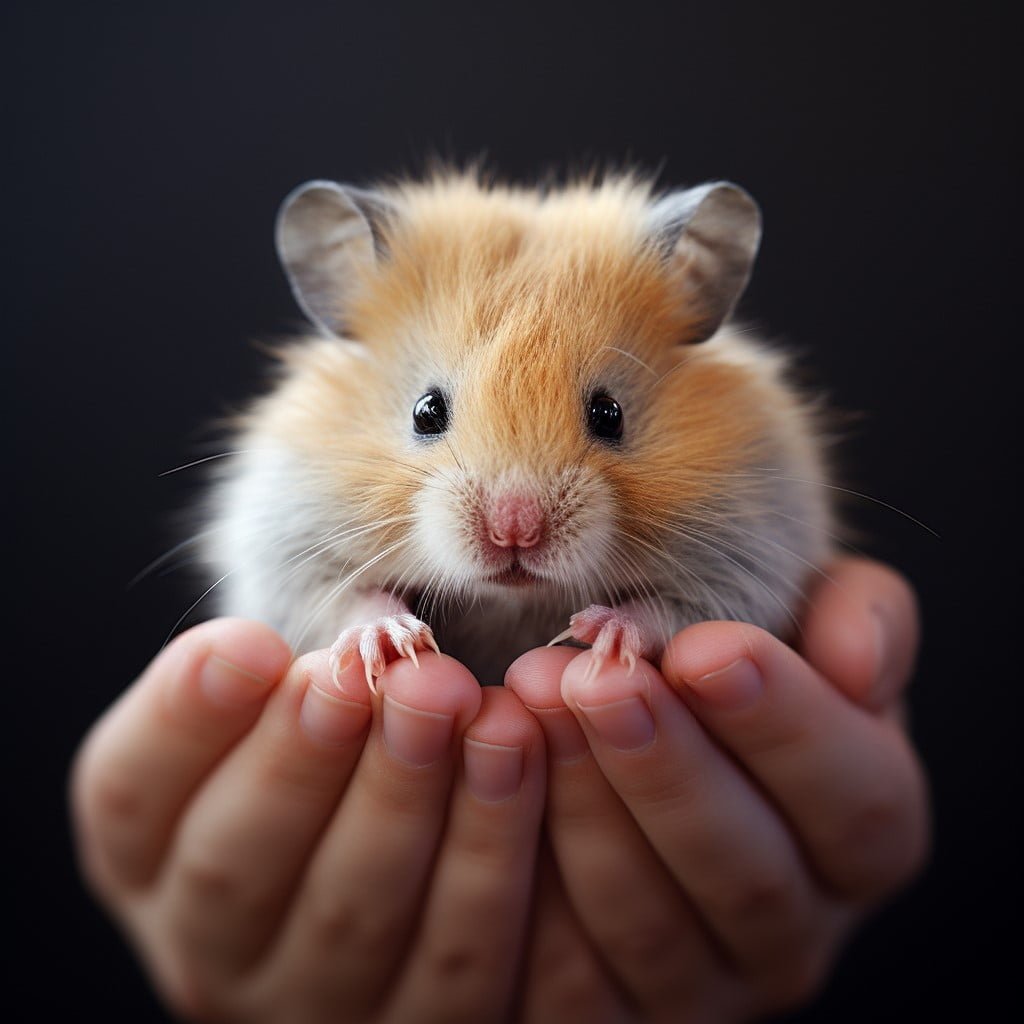Your Ultimate Hamster Wheel Guide to Keeping Your Furry Friend Fit and Happy
Hamsters are adorable and fascinating pets that have captured the hearts of many animal lovers around the world. One of the most iconic and essential accessories for a hamster’s habitat is the wheel. It’s not just a toy; it’s a crucial element in providing your furry friend with physical exercise and mental stimulation. In this comprehensive guide, we’ll delve deep into the world of hamster wheels, covering everything from types and sizes to proper usage and maintenance. Whether you’re a seasoned hamster owner or a newbie in the pet world, this guide will provide you with all the information you need to keep your pet healthy and happy.
The Importance of Hamster Wheels


Hamsters are naturally active creatures that require regular exercise to maintain their physical and mental well-being. In the wild, they cover significant distances each night in search of food and to explore their surroundings. When kept as pets, hamsters still possess these instincts, and it’s our responsibility as owners to provide them with an environment that allows for such activities.
A hamster wheel, sometimes referred to as an exercise wheel or running wheel, is a key accessory in achieving this. It provides an outlet for your pet’s energy, reduces stress, and helps prevent obesity. Additionally, it can be a source of entertainment for both you and your furry friend.
The Anatomy of a Hamster Wheel
Before we dive deeper into the world of hamster wheels, it’s important to understand its basic components. A typical wheel consists of:
- Wheel: The circular running surface where your hamster runs or walks.
- Axle: The rod that goes through the wheel, allowing it to spin.
- Stand or Holder: The frame that holds the wheel in place.
- Base: The bottom part of the wheel that rests on the cage floor.
- Treads or Rungs: The textured surface on which your hamster grips as it runs.
Each of these components plays a crucial role in ensuring the wheel functions correctly and safely.
Types of Hamster Wheels
When it comes to hamster wheels, there are several types to choose from, each with its own set of advantages and disadvantages. Let’s take a closer look at the most common types:
Traditional Hamster Wheels
Traditional wheels are the most recognizable and widely used type. They are usually made of plastic or metal and have a solid running surface with rungs or treads for your hamster to run on. These wheels come in various sizes to accommodate different hamster breeds.
| PROS | CONS |
|---|---|
| – cost-effective | – some traditional wheels can be noisy |
| – available in various sizes | – may have a tendency to wobble |
| – easy to clean |
Silent Hamster Wheels
If noise is a concern for you, especially if your hamster’s cage is in a bedroom or living area, silent hamster wheels are an excellent choice. These wheels are designed to minimize or eliminate the squeaking and rattling sounds often associated with traditional wheels.
| PROS | CONS |
|---|---|
| – virtually silent operation | – usually more expensive than traditional wheels |
| – available in various sizes | – require occasional maintenance to remain quiet |
| – promotes a peaceful environment |
Flying Saucer Wheels

Flying saucer wheels are a unique alternative to traditional wheels. They have a saucer-like design that allows your hamster to run on a tilted surface. These wheels can be a great option for hamsters that enjoy a different running experience.
| PROS | CONS |
|---|---|
| – engages your hamster’s curiosity | – not suitable for all hamster breeds |
| – takes up less cage space | – some hamsters may take time to adjust to the tilted surface |
| – can be more comfortable for hamsters with back problems |
Mesh and Solid Surface Wheels
Some wheels have a solid surface, while others are made of mesh. The choice between these two options depends on your hamster’s preferences and specific needs.
| Solid Surface | Mesh |
|---|---|
| provide a stable running surface | allow for better airflow |
| prevent small feet from getting caught | can be more comfortable for some hamsters |
| easy to clean | hamsters can grip the mesh for better traction |
When selecting a wheel, consider your hamster’s comfort and safety, as well as your own preferences for maintenance and noise levels.
Choosing the Right Size
Hamster wheels come in various sizes to accommodate different breeds and sizes of hamsters. Choosing the right size wheel is essential for your pet’s comfort and safety. Here’s a breakdown of the ideal wheel size for common hamster breeds:
Syrian Hamsters
Syrian hamsters are the largest of the pet hamster breeds and require a larger wheel to accommodate their size. A wheel with a diameter of at least 8 inches (20 cm) is recommended to ensure that your Syrian hamster can run comfortably without arching its back.
Dwarf Hamsters
Dwarf hamsters, including Roborovski and Russian Campbell hamsters, are smaller and more delicate than Syrians. A wheel with a diameter of 6 to 7 inches (15 to 18 cm) is typically suitable for dwarf hamsters.
Roborovski Hamsters
Roborovski hamsters are the smallest among the dwarf hamster species. For these tiny creatures, a wheel with a diameter of 5 to 6 inches (12 to 15 cm) is appropriate.
Chinese Hamsters
Chinese hamsters fall between dwarf and Syrian hamsters in terms of size. They can comfortably use a wheel with a diameter of 6 to 7 inches (15 to 18 cm).
Choosing the right wheel size is crucial to prevent your hamster from developing back problems or injuries while exercising. If in doubt, opt for a larger wheel to ensure your hamster has plenty of room to run without strain.
Setting Up Your Hamster Wheel


Now that you’ve selected the appropriate type and size of the wheel for your hamster, it’s time to set it up in your pet’s habitat. Proper placement and security are key factors in ensuring your hamster’s safety and enjoyment.
Placement and Security
- Stability: Ensure that the wheel is securely attached to its stand or holder. Wobbly wheels can cause accidents and discomfort for your hamster.
- Location: Place the wheel in a quiet area of the cage, away from your hamster’s food and water sources. Hamsters may be more active at night, so consider the noise level if the cage is in your bedroom.
- Accessibility: Make sure the wheel is easily accessible to your hamster. Avoid placing it too high or too low in the cage, as this can make it difficult for your pet to use.
- Safety: Regularly inspect the wheel for any sharp edges, loose parts, or signs of wear and tear that could harm your hamster. Replace or repair as needed.
Cleaning and Sanitizing
Proper hygiene is crucial to health and prevents the buildup of bacteria or odor in the wheel. Here’s how to clean and sanitize your hamster wheel effectively:
- Regular Cleaning: Remove the wheel from the cage and wash it with mild soap and warm water at least once a week. Use a soft brush or toothbrush to scrub away dirt and residue.
- Disinfection: Every few weeks, disinfect the wheel by soaking it in a diluted solution of pet-safe disinfectant. Rinse thoroughly and allow it to dry completely before returning it to the cage.
- Avoid Harmful Chemicals: Never use harsh chemicals or cleaners that could be harmful to your hamster. Stick to pet-safe products.
Using the Hamster Wheel
A hamster wheel is not just a piece of decor for your pet’s cage; it serves a vital purpose in keeping your hamster active and mentally stimulated. Understanding how to encourage your hamster to use the wheel and monitoring their activity is essential.
Signs of a Happy Hamster
When your hamster is using the wheel regularly, it’s a sign that they are content and healthy. Some indicators of a happy hamster include:
- Frequent Wheel Usage: Hamsters are crepuscular animals, which means they are most active during dawn and dusk. If you observe your hamster using the wheel during these periods, it’s a positive sign.
- Energetic Behavior: A happy hamster will also display playful and energetic behavior, such as running, jumping, and exploring its environment.
- Healthy Appetite: An active hamster is likely to have a healthy appetite, so monitor their food and water consumption.
Monitoring Usage
Keep an eye on how often and for how long your hamster uses the wheel. This will help you identify any potential issues or changes in your pet’s behavior. Consider these tips for monitoring wheel usage:
- Log Activity: Note the duration and frequency of use.
- Observe Changes: If you notice a sudden decrease in wheel usage or any signs of distress while using the wheel, investigate the cause promptly.
- Maintain Proper Nutrition: Ensure your hamster is receiving a balanced diet to support its energy levels and overall health.
Remember that each hamster is unique, and their activity levels may vary. Some hamsters are more active than others, so don’t be alarmed if your pet doesn’t use the wheel as much as you expect.
Maintaining the Hamster Wheel


To ensure your hamster’s wheel remains in good condition and continues to provide a safe and enjoyable exercise experience, regular maintenance is necessary. Here are some tasks to keep in mind:
Regular Cleaning
Cleaning the wheel is essential for hygiene and preventing odors. As mentioned earlier, clean the wheel at least once a week with mild soap and water. Scrub away any dirt or residue, rinse thoroughly, and dry it completely before returning it to the cage.
Lubrication
If your hamster wheel has moving parts, such as bearings or axles, consider lubricating them periodically to reduce friction and prevent squeaking. Use a pet-safe lubricant or consult the manufacturer’s recommendations for maintenance.
Inspecting for Wear and Tear
Regularly inspect the wheel for signs of wear and tear, such as cracks, loose parts, or broken treads. Replace any damaged components promptly to avoid injury to your hamster.
Additionally, check the stability of the wheel’s stand or holder to ensure it remains secure within the cage.
Common Problems and Solutions
While hamster wheels are generally straightforward and safe accessories, there are some common issues that hamster owners may encounter. Here are solutions to a few of these problems:
Noise Issues
If your hamster wheel is making excessive noise, it can disrupt your pet’s sleep and your own peace and quiet. Here are some ways to address noisy wheels:
- Lubrication: As mentioned earlier, lubricate moving parts to reduce friction and noise.
- Secure Placement: Ensure the wheel is securely attached to its stand or holder to prevent rattling.
- Consider a Silent Wheel: If noise remains a persistent issue, consider switching to a silent hamster wheel.
Hamster Not Using the Wheel
If your hamster isn’t using the wheel, it may need some encouragement or adjustments to its environment:
- Check Wheel Size: Ensure the wheel is the appropriate size for your hamster’s breed.
- Placement: Make sure the wheel is accessible and in a quiet area of the cage.
- Add Treats or Toys: Place some of your hamster’s favorite treats or toys near the wheel to entice them to explore it.
- Observe Behavior: Pay attention to your hamster’s behavior and try to understand any factors that might be preventing them from using the wheel.
Wheel Size Mismatch
Using the wrong-sized wheel for your hamster can lead to discomfort and potential health issues. If you realize you have the wrong-sized wheel, replace it with one that suits your pet’s size.
Safety Considerations


Although hamster wheels prioritize your pet’s safety, it’s essential to be aware of additional safety precautions, especially when you have children or other pets at home.
Child and Pet Safety
If you have curious children or other animals that might interact with your hamster’s cage, take the following precautions:
- Secure the Cage: Ensure the cage is securely latched and cannot be opened by children or pets.
- Supervise Interactions: Always supervise interactions between children, other pets, and your hamster. Never leave them unattended together.
- Educate Family Members: Teach children and family members about the importance of being gentle with the hamster and not disturbing it while it’s using the wheel.
Avoiding Accidents
To prevent accidents involving the hamster wheel, consider :
- Wheel Covers: Some hamster wheels come with covers or shields to prevent your hamster from flying out while running. These can be particularly useful if you have a particularly energetic hamster.
- Regular Inspections: As mentioned earlier, regularly inspect the wheel for any signs of wear or damage that could pose a safety risk.
Final thoughts
A hamster wheel is not just a fun addition to your pet’s cage; it’s a vital tool for promoting their physical and mental well-being. Choosing the right type and size of the wheel, setting it up correctly, and maintaining it regularly are all essential steps in ensuring your hamster’s health and happiness.
Remember to monitor your hamster’s wheel usage, keep it clean and safe, and address any issues promptly. By following the guidelines in this comprehensive hamster wheel guide, you’ll provide your furry friend with the best possible environment for exercise and enjoyment.
FAQ about hamster wheels
Q: Why does my hamster need a wheel?
Hamsters are naturally active animals, and wheels provide them with exercise and mental stimulation. Without a wheel, hamsters may become bored and less physically fit.
Q: What are some popular hamster wheel brands
Some popular hamster wheel brands include Kaytee Silent Spinner, Exotic Nutrition Silent Runner, Trixie Exercise Wheel, Suncoast Sugar Gliders Wodent Wheel, and Ware Manufacturing Flying Saucer Wheel.
Q: Are all hamster wheels the same size?
No, hamster wheels come in various sizes. The size of the wheel should be appropriate for your hamster’s breed. Syrian hamsters typically need a larger wheel (8-12 inches), while dwarf hamsters can use a smaller one (6-8 inches).
Q: How do I choose the right hamster wheel for my pet?
Consider your hamster’s size, breed, and preferences. Look for a wheel with safety features like no-spoke designs, sturdy bases, and a solid running surface.
Q: How often should I clean my hamster’s wheel?
You should clean your hamster’s wheel at least once a week to prevent dirt and bacteria buildup. Deep cleaning can be done monthly or as needed.
Q: What should I use to clean my hamster’s wheel?
Use warm soapy water and a soft brush for regular cleaning. Pet-safe cleaning solutions can be used for deep cleaning.
Q: Can I use household cleaning products on my hamster’s wheel?
Avoid using harsh chemicals or household cleaning products, as they can harm your hamster. Stick to pet-safe cleaning solutions.
Q: How can I ensure my hamster’s safety while using the wheel?
Regularly inspect the wheel for signs of wear and tear. Ensure it’s stable and not prone to tipping over. Avoid wheels with spokes that can trap a hamster’s feet.
Q: Are there alternative exercise options for hamsters besides wheels?
While wheels are a common choice, you can also provide hamster balls or tunnels for exercise and mental stimulation. Ensure these alternatives are safe and appropriate for your pet.
Q: What if my hamster doesn’t use the wheel?
Some hamsters may not immediately take to using a wheel. Be patient and give them time to adjust. You can also try different wheel types or place treats near the wheel to encourage exploration.
Further Resources and Recommendations
If you want to dive even deeper into the world of hamster care and enrichment, consider exploring the following resources:
- Books and guides on hamster care and behavior.
- Online hamster forums and communities for advice and support from experienced hamster owners.
- Consultation with a veterinarian specializing in small animals for personalized care recommendations.
- In-depth post about care in the section Lear & Care
Your hamster’s well-being is a rewarding responsibility, and with the right knowledge and care, you can ensure a happy and healthy life for your beloved pet.

